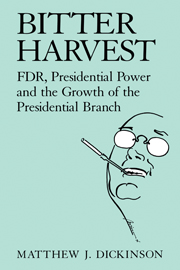Book contents
- Frontmatter
- Contents
- Preface and acknowledgments
- Introduction: The fruits of his labor? FDR and the growth of the presidential branch
- Part I Concepts and controversies
- Part II From cabinet to presidential government, 1933–9
- Part III Testing Roosevelt's staff system: The war years, 1939–45
- 4 Economic mobilization and World War II
- 5 Managing war production
- 6 FDR and the national security bureaucracy
- 7 The commander in chief
- Part IV Lessons and considerations
- References
- Indexes
5 - Managing war production
Published online by Cambridge University Press: 21 January 2010
- Frontmatter
- Contents
- Preface and acknowledgments
- Introduction: The fruits of his labor? FDR and the growth of the presidential branch
- Part I Concepts and controversies
- Part II From cabinet to presidential government, 1933–9
- Part III Testing Roosevelt's staff system: The war years, 1939–45
- 4 Economic mobilization and World War II
- 5 Managing war production
- 6 FDR and the national security bureaucracy
- 7 The commander in chief
- Part IV Lessons and considerations
- References
- Indexes
Summary
The Japanese attack and America's formal entry into World War II all but ended Roosevelt's concern regarding the isolationists' opposition against United States' military intervention overseas. Now his primary objective became maximizing the nation's military output as quickly as possible. That, however, necessitated overhauling the administration of war production. Accordingly, on Jan. 16, 1942, he replaced both SPAB and the OPM with the War Production Board (WPB), and charged it with insuring the production of finished capital goods and materials, military items, and consumer products (except for food, housing, and transportation). To accomplish these goals, the WPB was authorized to force manufacturers to accept military contracts, to requisition private property, and to stop the production of specified goods and services.
In effect, however, it was Donald Nelson who assumed these powers; the WPB served in a purely advisory capacity to him. Except for price control, Nelson essentially wielded authority over every aspect of the domestic defense effort. A Roosevelt memorandum to Nelson summarized the president's expectations regarding the division of labor between Nelson and the military:
[T]he Army and Navy should advise me what they want to fight with, how many of each munition is required and when they should be delivered. That is clearly a strategic military function.
… I do not expect the Army and Navy to then determine … how these items are to be rated as priorities or allocations. … The weapons are all important and they all must be built on schedule. […]
- Type
- Chapter
- Information
- Bitter HarvestFDR, Presidential Power and the Growth of the Presidential Branch, pp. 141 - 163Publisher: Cambridge University PressPrint publication year: 1996



